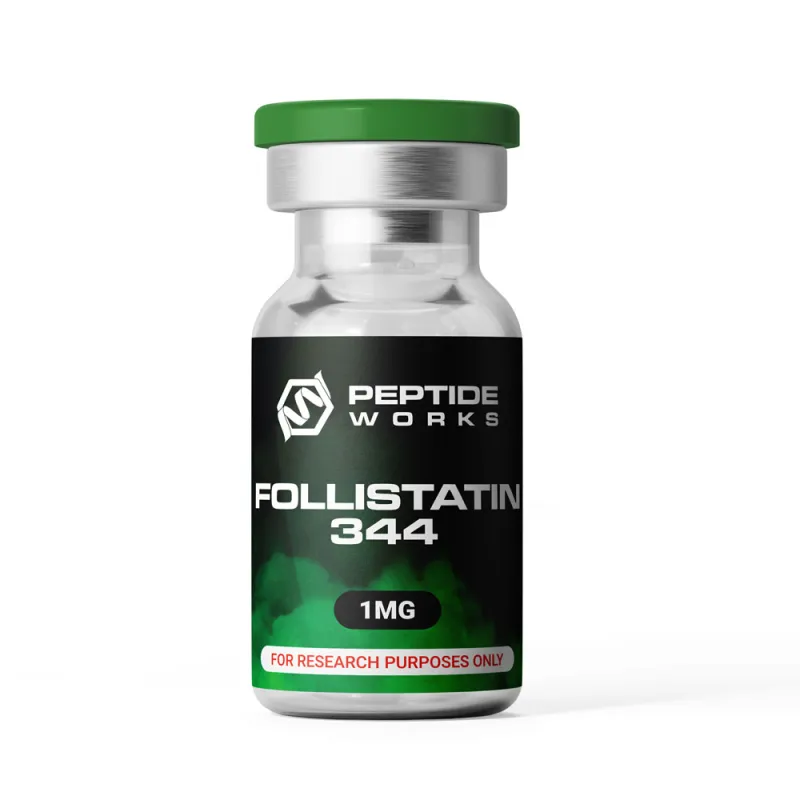
PROMO!
First order? Get 10% OFF with this code: 1storder
Written by

Follistatin Peptide is not a steroid. It is a natural protein found in muscles and blood. Steroids change hormone levels directly in the body.
Follistatin works in a different way. It binds to a protein called myostatin. Myostatin stops muscle growth. When follistatin binds to myostatin, it blocks this effect.
Research shows follistatin uses different paths than steroids. Scientists study how it affects GDF-8, another growth factor. These studies are still early stage.
More research is needed to understand how it works. This blocking process happens through a specific mechanism.
Explore Follistatin Peptide from Peptide Works, a research peptide that binds myostatin to promote muscle growth without hormonal interference.

Follistatin peptide works by directly binding to myostatin proteins in research studies. This binding stops myostatin from reaching muscle cell receptors.
When myostatin cannot bind to cells, it cannot limit muscle growth. Scientists found that follistatin peptide has special binding sites for myostatin. The peptide wraps around myostatin like a lock and key.
This blocking action happens outside muscle cells, not inside them. Research shows follistatin peptide also blocks related proteins like GDF-8.
Peptide Works supplies these compounds for laboratory research worldwide. Studies prove this binding method works better than other myostatin blockers. The peptide has specific areas designed for this binding.
Follistatin peptide has three main areas where it grabs onto myostatin. The first area sits at positions 3-26 on the peptide chain. The second area is located at positions 46-59, right next to the first one.
These two areas work together to catch myostatin proteins. The third area connects to other proteins at positions 72-86. Follistatin 344 keeps all three areas working properly for research studies.
This makes it useful for scientists who study how proteins stick together. One particular version stands out in research settings.

Scientists prefer Follistatin 344 because it stays stable in lab conditions longer than other types. This version moves freely through blood without sticking to cell surfaces.
Research shows it works better for muscle growth studies than shorter follistatin forms. The peptide also blocks GDF-8, which is another name for myostatin. Studies prove Follistatin 344 causes no bad side effects in lab animals.
It gives researchers cleaner results because it does not interfere with other body systems. GDF-8 plays a central role in this research.
Discover Follistatin 344 from Peptide Works, a long-acting peptide designed to block GDF-8, supporting advanced muscle growth studies.
GDF-8 is the scientific name for myostatin, making it the main target of follistatin research. Both proteins belong to the TGF-beta superfamily, which controls cell growth throughout the body.
Scientists study GDF-8 because it stops muscle from growing too much. When follistatin peptide binds to GDF-8, it blocks this growth-stopping signal completely.
Research shows GDF-8 works through specific cell receptors called ActRIIB. Follistatin peptide stops GDF-8 from reaching these receptors in lab studies.
This connection makes GDF-8 the primary research focus for follistatin studies worldwide. Both proteins belong to a larger protein family.
Explore GDF-8 Inhibitors from Peptide Works, advanced compounds targeting the key muscle growth regulator myostatin for muscle-wasting and regeneration studies.
The TGF-beta superfamily is a large group of proteins that control cell growth throughout the body. This protein family contains over 50 different members that work together to regulate development.
Scientists divide this superfamily into four main groups: TGF-beta proteins, bone proteins, activin proteins, and growth factors. All these proteins share similar structures made from amino acid chains.
They control how cells grow, divide, and change into different types. Follistatin peptide belongs to this superfamily because it regulates cell growth like other family members.
This classification proves follistatin peptide comes from proteins, not steroids. This family uses a specific control method.
The TGF-beta superfamily controls cell growth by sending signals through special pathways called SMAD proteins. These proteins work like messengers that carry growth instructions to cell centers.
The superfamily can either stop cells from growing or make them grow faster. It does this by binding to cell surface receptors that activate different SMAD types.
Research shows the system stops cell growth at a checkpoint called the R-point. Scientists study this process because follistatin peptide uses the same control system.
This growth control happens in all body tissues during development and repair. SMAD proteins are key messengers in this system.
SMAD proteins are special messenger molecules that carry growth signals inside cells. Scientists divide them into three main types that work in different ways.
The first type called R-SMADs gets activated by cell surface receptors directly. The second type called Co-SMADs helps R-SMADs move into the cell center.
The third type called I-SMADs stops growth signals when cells need to slow down. These proteins connect follistatin peptide research to actual cell changes.
All SMAD types have two main parts that help them work properly. Steroids work completely differently.

No, steroids do not use SMAD signaling pathways at all. Steroids work by binding directly to hormone receptors inside cell centers.
They skip the SMAD messenger system completely and go straight to DNA. Follistatin peptide must use SMAD proteins to send growth control signals through cells.
This proves steroids and follistatin peptide work through completely different body systems. Steroids change hormone levels while follistatin peptide only affects protein messages.
Scientists can easily tell them apart because their cell pathways never overlap.
Follistatin peptide shows potential for targeted muscle research applications without steroid-related complications. Clinical trials are advancing toward applications for muscle-wasting diseases and metabolic disorders.
Scientists continue exploring gene therapy applications using Follistatin 344 for muscular dystrophy patients. The compound’s protein-based structure demonstrates therapeutic advantages over hormone-based treatments.
Research focuses on sarcopenia treatment, diabetes management, and tissue regeneration applications. Peptide Works provides follistatin peptide compounds to research laboratories worldwide.
Studies indicate this peptide targets myostatin pathways more precisely than traditional muscle-building compounds.
All products discussed are supplied for research purposes only and are not intended for human use.
[1] Tsuchida K. Myostatin inhibition by a follistatin-derived peptide ameliorates the pathophysiology of muscular dystrophy model mice. Acta Myol. 2008 Jul;27(1):14-8.
[2] Rodino-Klapac LR, Haidet AM, Kota J, Handy C, Kaspar BK, Mendell JR. Inhibition of myostatin with emphasis on follistatin as a therapy for muscle disease. Muscle Nerve. 2009 Mar;39(3):283-96.
[3] Ciarmela P, Bloise E, Gray PC, Carrarelli P, Islam MS, De Pascalis F, Severi FM, Vale W, Castellucci M, Petraglia F. Activin-A and myostatin response and steroid regulation in human myometrium: disruption of their signalling in uterine fibroid. J Clin Endocrinol Metab. 2011 Mar;96(3):755-65.
[4] Mullen AC, Wrana JL. TGF-β Family Signaling in Embryonic and Somatic Stem-Cell Renewal and Differentiation. Cold Spring Harb Perspect Biol. 2017 Jul 5;9(7):a022186.
ALL CONTENT AND PRODUCT INFORMATION AVAILABLE ON THIS WEBSITE IS FOR EDUCATIONAL PURPOSES ONLY.
DISCLAIMER: These products are intended solely as a research chemical only. This classification allows for their use only for research development and laboratory studies. The information available on our Peptide Works website: https://peptide-works.com/ is provided for educational purposes only. These products are not for human or animal use or consumption in any manner. Handling of these products should be limited to suitably qualified professionals. They are not to be classified as a drug, food, cosmetic, or medicinal product and must not be mislabelled or used as such.
Peptide Works
Related Articles

Best Peptides for Women in Perimenopause: From Libido to Energy
Do you feel drained, struggle with focus, or notice your drive slipping during perimenopause? These changes are some of the

PT-141 for Women in Perimenopause: A Breakthrough for Low Libido
Perimenopause can bring more than just physical changes it often affects how women feel about intimacy, confidence, and connection. Many

Can Vitamin B12 Immune System Support Enhance the Effects of Thymosin Alpha-1?
The Vitamin B12 immune system link is important because this vitamin plays a crucial role in DNA synthesis, methylation, energy